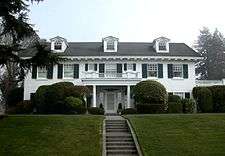Colonial Revival architecture

Colonial Revival (also Neocolonial, Georgian Revival or Neo-Georgian) architecture was and is a nationalistic design movement in the United States. Part of a broader Colonial Revival Movement embracing Georgian and Neoclassical styles, it seeks to revive elements of architectural style, garden design, and interior design of American colonial architecture.
The Centennial Exhibition of 1876 reawakened Americans to their colonial past. This movement gained momentum in the 1890s and was accelerated by the early 20th century advent of the automobile, which expanded the ability of ordinary Americans to visit sites connected with their heritage.
History
Successive waves of revivals of British colonial architecture have swept the United States since 1876. In the 19th century, Colonial Revival took a formal style. Public interest in the Colonial Revival style in the early 20th century helped popularize books and atmospheric photographs of Wallace Nutting showing scenes of New England. Historical attractions such as Colonial Williamsburg helped broaden exposure in the 1930s.
In the post-World War II era, Colonial design elements were merged with the then popular ranch-style house design. In the early part of the 21st century, certain regions of the United States embraced aspects of Anglo-Caribbean and British Empire styles.
Defining characteristics

Colonial Revival sought to follow American colonial architecture of the period around the Revolutionary War, which drew strongly from Georgian architecture of Great Britain.
Structures are typically two stories with the ridge pole running parallel to the street, have a symmetrical front facade with an accented doorway, and evenly spaced windows on either side of it.
Features borrowed from colonial period houses of the early 19th century include elaborate front doors, often with decorative crown pediments, fanlights, and sidelights, symmetrical windows flanking the front entrance, often in pairs or threes, and columned porches.
See also
- Dutch Colonial Revival architecture
- Mission Revival Style architecture
- Spanish Colonial Revival architecture
- Colonial Revival garden
- New Classical architecture
Further reading
- A. Axelrod, The Colonial Revival in America 1985.
- William Butler, Another City Upon a Hill: Litchfield, Connecticut, and the Colonial Revival
- Karal Ann Marling, George Washington Slept Here: Colonial Revivals and American Culture, 1876–1986 1988.
- Richard Guy Wilson and Noah Sheldon, The Colonial Revival House 2004.
- Richard Guy Wilson, Shaun Eyring and Kenny Marotta, Re-creating the American Past: Essays on the Colonial Revival 2006.
External links
| Wikimedia Commons has media related to Colonial Revival architecture. |
- Photo Gallery of Colonial Revival houses
- Examples of Colonial Revival in Buffalo, New York
- 1876 Centennial Information
- Colonial Revival architecture at Hill-Stead Museum, Farmington, Connecticut
- Colonial Style Homes Exude Tradition - Patriotic